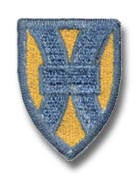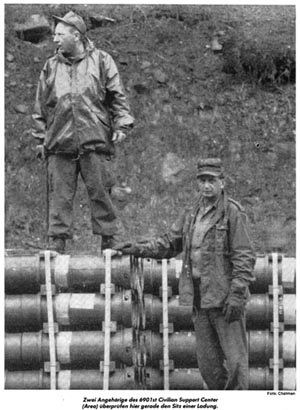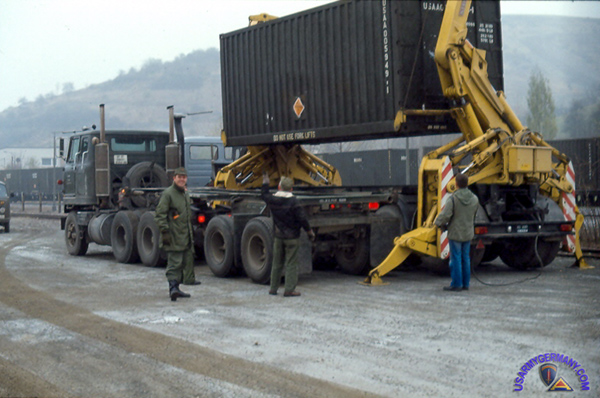| If you do
NOT see the Table of Contents frame to the left of this page, then
Click here to open 'USArmyGermany' frameset |
|||||||||||||||||||||||||||||||||||||||||||||||||||||||||||||||||||||||||||||
|
60th
Ordnance Group |
|||||||||||||||||||||||||||||||||||||||||||||||||||||||||||||||||||||||||||||
|
|
|||||||||||||||||||||||||||||||||||||||||||||||||||||||||||||||||||||||||||||
|
|||||||||||||||||||||||||||||||||||||||||||||||||||||||||||||||||||||||||||||
|
|
|||||||||||||||||||||||||||||||||||||||||||||||||||||||||||||||||||||||||||||
| 6901st Civilian Support Center (Area) | |||||||||||||||||||||||||||||||||||||||||||||||||||||||||||||||||||||||||||||
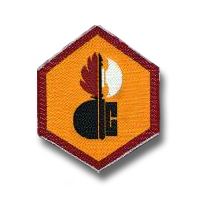 6901st CSC (Area) Patch (courtesy
Siegbert Mann)
6901st CSC (Area) Patch (courtesy
Siegbert Mann) |
|||||||||||||||||||||||||||||||||||||||||||||||||||||||||||||||||||||||||||||
|
(Source:
Zweibrücken Sun, May 15, 1985)
|
|||||||||||||||||||||||||||||||||||||||||||||||||||||||||||||||||||||||||||||
|
Zweibrücken
civilians earn high decoration
Two civilian employees in the Zweibrücken Community recently attended the Annual Incentive Awards Ceremony, held at the Heidelberg Officers and Civilian's Club in Patrick Henry Village. Zygmunt K. Lewandowski was awarded the Outstanding Civilian Service Award, while Michael P. Lynch was given the Secretary of the Army Award for Outstanding Suggestor. The awards, presented only once a year, are signed by the Secretary of the Army. To be nominated for such decorations, employees must have accomplished assigned duties of major program significance to the Department of the Army. They must have also developed and improved major methods and procedures, inventions or other achievements that effected large scale savings to the government. Or, they must have provided outstanding leadership to the administration of major Army commands. Lynch was a quality assurance specialist at Miesau Army Depot, but is currently stationed in Wildflecken. Throughout 1983, he actively participated in the Suggestor Program with the submission of eight suggestions. Most of these included suggestions of improvement with the APE 2199, a precision machine used in the production of ammunition. Through just six of his suggestions, Lynch received a small personal reward of over $2,000 for tangible savings to the Army totaling $64,407. |
|||||||||||||||||||||||||||||||||||||||||||||||||||||||||||||||||||||||||||||
|
|||||||||||||||||||||||||||||||||||||||||||||||||||||||||||||||||||||||||||||
|
|
|||||||||||||||||||||||||||||||||||||||||||||||||||||||||||||||||||||||||||||
|
Webmaster
Note: The three Civilian Support Centers activated under CONPLAN
were the following:
|
|||||||||||||||||||||||||||||||||||||||||||||||||||||||||||||||||||||||||||||
|
|||||||||||||||||||||||||||||||||||||||||||||||||||||||||||||||||||||||||||||
|
The
six Civilian Support Groups activated under CONPLAN were the following:
|
|||||||||||||||||||||||||||||||||||||||||||||||||||||||||||||||||||||||||||||
|
|||||||||||||||||||||||||||||||||||||||||||||||||||||||||||||||||||||||||||||
(Source: Support Sentinel, June 18 1985) |
|||||||||||||||||||||||||||||||||||||||||||||||||||||||||||||||||||||||||||||
Civilian support units mark 40 years' service By Juergen Haarnagel 60th Ord Gp PAO The Zweibruecken-based 6901st Civilian Support Center (Area) and its subordinate units celebrated their 40th anniversary May 15 at Turley Barracks, Mannheim. The event was sponsored by the 6851st Civilian Support Center. Keynote speaker Zygmunt K. Lewandowski, superintendent of the 6901st, outlined the postwar role of the US Forces in providing a new life for Poles liberated from German POW camps and unable to return to their native land after the war. "They never gave up or got lost in the jumble of the initial postwar chaos," Lewandowski said. The US Forces began hiring Poles in May 1945 to form labor service companies, providing them with educational and recreational facilities, churches and Polish newspapers. "Since 1945, many changes have occurred in the organization, mission and personnel of labor service companies," he said. "In 1981, the term 'civilian support' replaced the designation 'labor service.' Today there are 94 CS groups composed predominately of German nationals." Teamwork and devotion to duty are hallmarks of the partnership between the 60th Ordnance Group and the 19 civilian support groups of the 6901st, according to Col John R. Morgan, commander of the 60th Ord Gp. "The civilian support units have been the mainstay of ammunition logistics in USAREUR for many years," he said, and CS employees are "the backbone of the ammunition reorganization" within the 60th. Following his remarks, Morgan presented length of service awards to 22 CSG employees. Aleksander Antoni of the Viernheim-based 2049th CSG (Guard) was the sole recipient of a 40 year service award. Employees cited for 35 years of service were Jan Augustiniak, Bronislaw Hoch and Marian Zapart, 2042nd CSG, Miesau; Leonas Menzel and Waclaw Przendzielewski, 2048th CSG, Kirchheimbolanden; Stanislaw Dudek and Kazimierz Grochowski, 2049th CSG; Wladyslaw Swierczek, 2050th CSG, Karlsruhe; Wladyslaw Galuszka and Ryszard Grzeskowiak, 2054th, Bad Kreuznach; Arno Heid, 6952nd CSC, Miesau; and Leon Palka and Antoni Niebieszczanski, 7418th CSG, Miesau. Cited for 30 years of service were Josef Kaminski and Edward Pietras, 2050th CSG; Jozef Podhajski, 2054th CSG; and Kazimierz Grabowski and Imre Mohacsi, 7418th CSG. Jan Kliman of the 2041st CSG, Mannheim, and Heinz Goerlitz and Valentin Ress of the 2054th CSG were honored for 25 years of service. |
|||||||||||||||||||||||||||||||||||||||||||||||||||||||||||||||||||||||||||||
|
|
|||||||||||||||||||||||||||||||||||||||||||||||||||||||||||||||||||||||||||||
| 6951st Civilian Support Center | |||||||||||||||||||||||||||||||||||||||||||||||||||||||||||||||||||||||||||||
(Source: Peter Neuen, 6951st CSC, Mannheim) |
|||||||||||||||||||||||||||||||||||||||||||||||||||||||||||||||||||||||||||||
| I became a member of the 6951st CSC at Turely Barracks in Mannheim shortly after it was formed - end of 1984/early 1985.(1) The XO of the 191st Ord Bn, our partner unit, was Major Robert Snyder. He arrived about half a year after I joined the 6951st. CO of the 6951st was ZB-10 Zbignew Janutowsky; XO was Z-9 Raimond Zawalsky. Additional officers:
Officers in the 191st Ord Bn partner unit:
Training officers for members of the 6951st CSC were ZB-6 Rolf Braner and ZB-6 Petra Becker. NBC was handled by ZB-5 Armin Besenfelder; Communications by ZB-4 Kuckuck. ZB-6 Schäfer was in S-1; additional members of the S-2 section were ZB-5 Gärtner and ZB-5 Krause. Responsible for the Ammunitions Section were ZB-9 Rank and ZB-8 Paulus. My section, S-2, was responsible for the physical security of the ammo storage sites in Guard units were the Before being assigned to the 6951st, I served with the 4094th CSG (Guard) at Hammonds Barracks in Mannheim-Seckenheim (1983-1984). ZB-9 Becker was commander; ZB-8 Zeising the XO; ZB-7 Nowak was the Supply Officer; and ZB-7's Ruffing, Müller and Vogt were Guard Operations Supervisors. (1) Webmaster note: the 6951st was formed under the CONPLAN project. (2) Prestock Point designations and storage site GOGGLE locations added by webmaster. ADDITIONAL INFORMATION I have added the names of the 191st XO and S-1 (see above lisitng). At the time that the 6951st CSC was formed, the unit was stationed at Turley Bks, Mannheim-Käfertal. |
|||||||||||||||||||||||||||||||||||||||||||||||||||||||||||||||||||||||||||||
| 6952nd Civilian Support Center | |||||||||||||||||||||||||||||||||||||||||||||||||||||||||||||||||||||||||||||
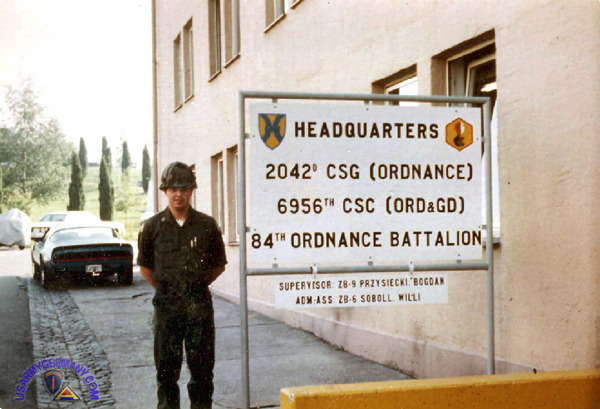 Major (ZB-9) Bogdan Przysiecki next to company sign, Zweibruecken, 1988 (Bogdan Przysiecki) |
|||||||||||||||||||||||||||||||||||||||||||||||||||||||||||||||||||||||||||||
| 2042nd Civilian Support Group (Ordnance) | |||||||||||||||||||||||||||||||||||||||||||||||||||||||||||||||||||||||||||||
|
(Source:
Das USAREUR Echo, August 1984)
|
|||||||||||||||||||||||||||||||||||||||||||||||||||||||||||||||||||||||||||||
| Anniversary The 2042nd Civilian Support Group (Ord) was formed on Aug 1 1977 as a subordinate unit of the 6956th CSC (Ord & Guard). Hqs of the unit was located at Kreuzberg Ksn, Zweibrücken with elements in: Sometime later, the unit was assigned to the 84th Ord Bn in Münchweiler. On Nov 1 1983, in accordance with the new Ammunition Concept (CONPLAN), the unit was moved to Miesau and reorganized, with its subordinate elements redesignated as separate units with their own missions. On Feb 1 1984, the 2042nd was augmented with personnel transferred from the 7418th CSG. Currently, the unit is under the operational control of the Miesau Army Depot (MIAD) and under the administrative control of the 6952nd CSC (Ord & Guard). The unit's MISSION: to receive, store, issue, sort, handle, maintain and conserve conventional ammo. |
|||||||||||||||||||||||||||||||||||||||||||||||||||||||||||||||||||||||||||||
(Source: Email from Bogdan Przysiecki, Miesau Army Depot) |
|||||||||||||||||||||||||||||||||||||||||||||||||||||||||||||||||||||||||||||
|
|||||||||||||||||||||||||||||||||||||||||||||||||||||||||||||||||||||||||||||
|
|||||||||||||||||||||||||||||||||||||||||||||||||||||||||||||||||||||||||||||
|
|||||||||||||||||||||||||||||||||||||||||||||||||||||||||||||||||||||||||||||
|
|||||||||||||||||||||||||||||||||||||||||||||||||||||||||||||||||||||||||||||
|
|||||||||||||||||||||||||||||||||||||||||||||||||||||||||||||||||||||||||||||
|
|||||||||||||||||||||||||||||||||||||||||||||||||||||||||||||||||||||||||||||
|
|||||||||||||||||||||||||||||||||||||||||||||||||||||||||||||||||||||||||||||
|
|||||||||||||||||||||||||||||||||||||||||||||||||||||||||||||||||||||||||||||
|
|||||||||||||||||||||||||||||||||||||||||||||||||||||||||||||||||||||||||||||
|
|||||||||||||||||||||||||||||||||||||||||||||||||||||||||||||||||||||||||||||
|
|||||||||||||||||||||||||||||||||||||||||||||||||||||||||||||||||||||||||||||
|
|||||||||||||||||||||||||||||||||||||||||||||||||||||||||||||||||||||||||||||
|
|||||||||||||||||||||||||||||||||||||||||||||||||||||||||||||||||||||||||||||
|
|||||||||||||||||||||||||||||||||||||||||||||||||||||||||||||||||||||||||||||
| 9. Awards and Decorations: FY 86 2nd place Annual Ammo Crew Competition within 21st SUPCOM FY 87 1st place Annual Ammo Crew Competition within 21st SUPCOM FY 88 1st place Annual Ammo Crew Competition within 21st SUPCOM FY 89 1st place Annual Ammo Crew Competition within 21st SUPCOM FY 88 Winner of USAREUR Unit Maintenance Excellence Award (Light TDA) FY 89 Winner of USAREUR Unit Maintenance Excellence Award (Light TDA) FY 88 Winner of Army Unit Maintenance Excellence Award (Light TDA) FY 89 Runner up of Army Unit Maintenance Excellence Award (Light TDA) |
|||||||||||||||||||||||||||||||||||||||||||||||||||||||||||||||||||||||||||||
|
|
|||||||||||||||||||||||||||||||||||||||||||||||||||||||||||||||||||||||||||||
| 6953rd Civilian Support Center | |||||||||||||||||||||||||||||||||||||||||||||||||||||||||||||||||||||||||||||
| (Source: Traveler, May 2, 1985) | |||||||||||||||||||||||||||||||||||||||||||||||||||||||||||||||||||||||||||||
|
Civilian
Support Groups: The latest addition to the Rheinberg Community
By Sp5 Jerome Coleman If you've been in the Reichel Building or Moenchengladbach lately, you've probably already seen the lastest addition to the Community -- the civilian support group. At first glance they probably looked like American soldiers, but a closer look told the story. The new soldiers you saw are members of the civilian support group. They're German citizens that are hired and trained by the U.S. Army. They provide a means of augumenting our forces with a work force that is capable of performing both peace and wartime missions according to MAJ Felix G. Banis, Battalion Commander, 196th Ordnance Battalion. The CSG should not be confused with local nationals that work for the government. "They wear the fatigue uniform and are part of a new "hybrid concept" of military and civilians working together to preserve peace," Barris explained. History of civilian support group The CSG may seem to be new to some but it was actually established after World War II. "Initially they were immigrants from Poland, Lutherans, and many anti-communists who Americans felt responsible for after the war, " said ZB10 Eberhardt Waadt, CSG Supervisor. "The U.S. Army employed these men, trained them and organized them into support units," Waadt explained. At that time they were mainly transportation, maintenance, and supply units that supported the U.S. Army he recalled. "Today, the 2056th CSG (Ordnance) and the 4006th CSG (Guard) are the primary work force in Twisteden," Barris said. These guard and ordnance personnel support the 196th Ordnance Battalion. "They will guard and man the ammunition bunkers now being constructed in Twisteden," Banis added. |
|||||||||||||||||||||||||||||||||||||||||||||||||||||||||||||||||||||||||||||
 Members of the 2056th CSG prepare bunkers for storage of ammunition at Twisteden, 1985. |
|||||||||||||||||||||||||||||||||||||||||||||||||||||||||||||||||||||||||||||
| Hiring
through local labor office Hiring began in February. "The local labor office directed people to us," Banis said. "We also contacted the Bundeswehr to interest experienced people that would be leaving the service soon." Although ability was one of the main concerns in hiring personnel, physical fitness was also an important factor. Banis explained that individuals applied directly. They were screened and then given an extensive physical. "Only the physically fit were hired and then trained," he said. Basic, advanced training CSG personnel were trained in phases. "Phase I was conducted in Twisteden," according to 2LT Gilles Reimer, Adjutant, 196th Ordnance Battalion. "This training is simular to basic training for soldiers. Personnel are taught how to wear the uniform and how to read the CSG labor laws." Phase II training provided personnel with the basic survival skills. Some personnel received this training in Rheinberg, others in Kaiserslautern. "During phase II training individuals received NBC training and first aid," Reimer said. "Safety was also emphasized." The last phase of training is on-the-job. Guards returned to Twisteden while Ordnance personnel went to Zweibrucken for further training. Reimer said that all CSG personnel had one week of classroom training and an additional week of on-the-job training. Not all CSG personnel needed training. For example, ZB10 Eberhardt Waadt, CSG Supervisor, is a retired Bundeswehr Colonel with years of experience in munitions. CSG structured much like U.S. military The CSG force is structured much like the U.S. Army. "There is no rank structure, but we do wear symbols," Waadt explained. "These symbols designate responsibility. ZB 7-10 designate commissioned officers while 1-6 represent the lower enlisted." |
|||||||||||||||||||||||||||||||||||||||||||||||||||||||||||||||||||||||||||||
|
|
|||||||||||||||||||||||||||||||||||||||||||||||||||||||||||||||||||||||||||||
| 6956th Civilian Support Center | |||||||||||||||||||||||||||||||||||||||||||||||||||||||||||||||||||||||||||||
| (Source: STARS & STRIPES, Nov 11, 1971) | |||||||||||||||||||||||||||||||||||||||||||||||||||||||||||||||||||||||||||||
| The 6956th Labor Service Ammunition & Guard Center is responsible for guarding and issuing ammunition at 38 different sites. The 6956th is a subordinate unit of the US Army Materiel Command, Europe (MATCOM). Superintendent of the 6956th is Stanislaw Szywalski. |
|||||||||||||||||||||||||||||||||||||||||||||||||||||||||||||||||||||||||||||
| Related Links: Ammo sites in Saarland - great page on the ammunition storage sites operated by the 60th Ord Gp in the Saarland. Page is hosted on the German website - Geschichtsspuren.de (formerly LostPlaces.de) |
|||||||||||||||||||||||||||||||||||||||||||||||||||||||||||||||||||||||||||||
